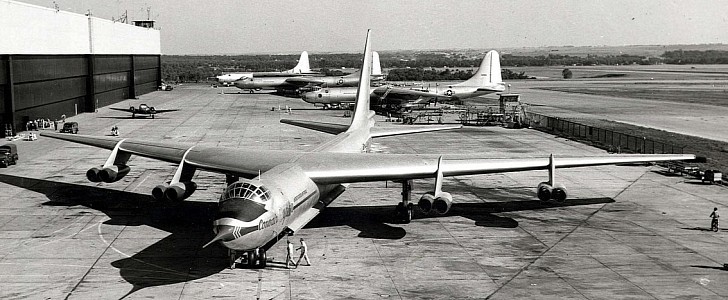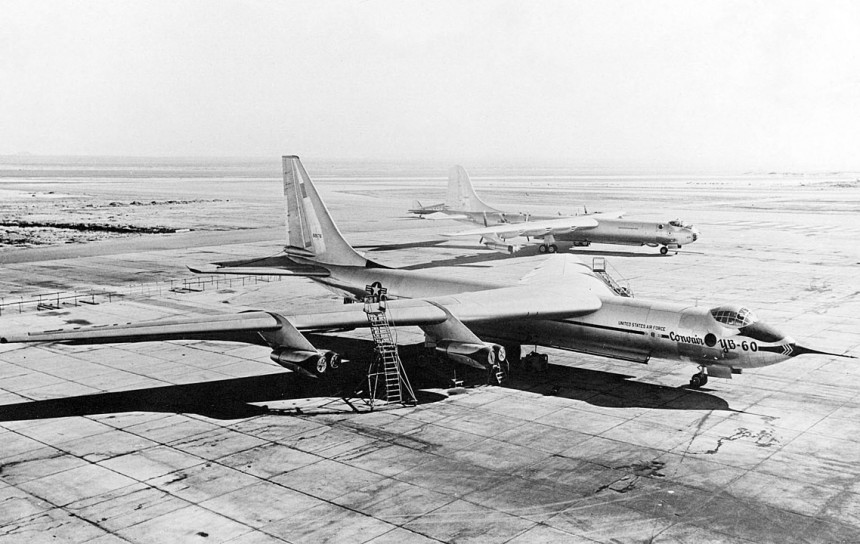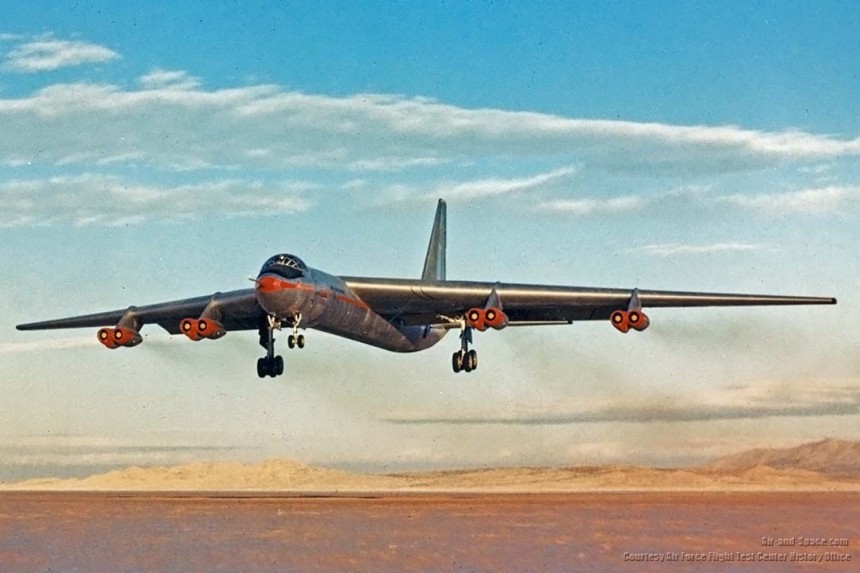When you're the U.S. Military, you go big or go home. But as it happens, even the Air Force has a limit when it comes to this ideology.
It's hard to judge where they draw this line. But the massive, gargantuan, and positively super-jumbo-sized Convair YB-60 jet bomber almost certainly crossed right over it. But to understand why the U.S. Air Force even bothered commissioning the design of such a ludicrously oversized strategic bomber, we need to understand the political climate of the day.
You've no doubt heard the story before. The Allies sweep into Germany from the east and west, plunder whatever they can of German technology, and then spend the next 50 years threatening to wipe each other out with nuclear fire. But before the top-secret German aerospace technology had even been settled on U.S. soil, a top-secret strategic bomber program was already taking to the skies. That, of course, is the colossal, piston-engined Coviar B-36 Peacemaker. An airplane so massive, it made a quad-engined Boeing B-29 Superfortress nuke-truck look like a DC-3.
The B-36 was the premiere strategic bomber in the U.S. Air Force's arsenal in the immediate aftermath of the Second World War. On top of seemingly being built for a 15-foot (5 meters), yeti-like creature with its size, it could also carry the king's share of conventional or nuclear weaponry, including the new-fangled hydrogen variety. There was more than a lot to like about the B-36 from a technical and aesthetical perspective.
But none of that could make up for the fact that warfare was changing drastically at this time, especially in the air. As it happens, around the same time the B-36 first took to the air, a slew of German engineers and their inventions as well found their way onto U.S. soil. It's been said that German aerospace technology was as much as five to ten years ahead of the Americans, Soviets, and the British by 1945.
The proof was in the pudding for these German designs. By their decree, jet power was to be the new standard for advanced aircraft. Replacing the radial and liquid-cooled piston-reciprocating engines that powered the largest bombers to the smallest private puddle jumpers for the first 50 years of manned flight. So too were broad, straight wings replaced by sleek, aerodynamic, swept-back wings to cut through high-speed air like a razor.
The B-36 had none of these things. In fact, it was starting to look like something of a dinosaur by the time the Americans entered the Korean War of 1950 to 1953. Convair knew something drastic was going to be needed to keep the Peacemaker a viable airframe. So, they devised what must have seemed like a no-brainer at the time.
Gone were the enormous Pratt & Whitney R-4360-53 Wasp Major 28-cylinder radial engines. In their place was a set of eight Pratt & Whitney J57-P-3 turbojet engines, making 8,700 lbs (39 kN) of thrust each. The engines were to be placed in four nacelles with two on each wing for even weight distribution across the massive 206 foot (63 m) wingspan.
The resulting airframe was so different from the base B-36 peacemaker that it was designated the YB-60 just before testing got underway. First taken to the sky on April 18th, 1952. Pilots were impressed by the capabilities of the YB-60 airframe, and it looked like a full production variant would be the next logical step. Unfortunately, the Boeing company had other ideas.
Around the same time that the YB-60 was taking to the air, Boeing was finalizing the design of their prototype YB-52. This prototype became a little aircraft you might know as the B-52 Stratofortress. The Stratofortress was so dazzling and capable in its abilities that it made the YB-60 look not all that much more useful at the Peacemaker it was supposed to replace. Thus, the YB-60 program was canceled, and the one airframe was scrapped. Meanwhile, the Stratofortress became the go-to American strategic bomber for the next 70 years. Check out the gallery above if you want to see more of this leviathan jet in action.
You've no doubt heard the story before. The Allies sweep into Germany from the east and west, plunder whatever they can of German technology, and then spend the next 50 years threatening to wipe each other out with nuclear fire. But before the top-secret German aerospace technology had even been settled on U.S. soil, a top-secret strategic bomber program was already taking to the skies. That, of course, is the colossal, piston-engined Coviar B-36 Peacemaker. An airplane so massive, it made a quad-engined Boeing B-29 Superfortress nuke-truck look like a DC-3.
The B-36 was the premiere strategic bomber in the U.S. Air Force's arsenal in the immediate aftermath of the Second World War. On top of seemingly being built for a 15-foot (5 meters), yeti-like creature with its size, it could also carry the king's share of conventional or nuclear weaponry, including the new-fangled hydrogen variety. There was more than a lot to like about the B-36 from a technical and aesthetical perspective.
But none of that could make up for the fact that warfare was changing drastically at this time, especially in the air. As it happens, around the same time the B-36 first took to the air, a slew of German engineers and their inventions as well found their way onto U.S. soil. It's been said that German aerospace technology was as much as five to ten years ahead of the Americans, Soviets, and the British by 1945.
The B-36 had none of these things. In fact, it was starting to look like something of a dinosaur by the time the Americans entered the Korean War of 1950 to 1953. Convair knew something drastic was going to be needed to keep the Peacemaker a viable airframe. So, they devised what must have seemed like a no-brainer at the time.
Gone were the enormous Pratt & Whitney R-4360-53 Wasp Major 28-cylinder radial engines. In their place was a set of eight Pratt & Whitney J57-P-3 turbojet engines, making 8,700 lbs (39 kN) of thrust each. The engines were to be placed in four nacelles with two on each wing for even weight distribution across the massive 206 foot (63 m) wingspan.
The resulting airframe was so different from the base B-36 peacemaker that it was designated the YB-60 just before testing got underway. First taken to the sky on April 18th, 1952. Pilots were impressed by the capabilities of the YB-60 airframe, and it looked like a full production variant would be the next logical step. Unfortunately, the Boeing company had other ideas.







